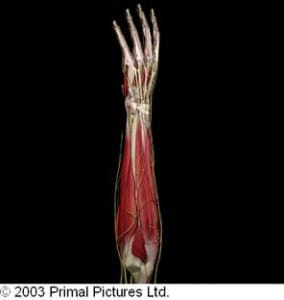INFORMATION ON REPETITIVE STRAIN INJURIES
In the absence of trauma, another major cause of wrist injury is overuse. This is particularly apparent in the computer operator population, whereby overuse is common and arises from positions that strain the finger tendons and wrist flexor and extensor muscles repetitively.

The diagnosis of repetitive strain injury (RSI) is often grouped together with other diagnoses, such as carpal tunnel syndrome and lateral epichondylitis, to describe repetitive strain injuries or cumulative trauma disorder that frequent the workplace. Figures from the Health and Safety Executive (HSE) showed that an estimated 2.8m working days were lost in 2007-8 due to RSI.
This is obviously very concerning and, as such, the ergonomics of these overuse problems have been studied intensively and technological advancements in design have been made with the aim to be proactive in reducing the onset of these conditions.
The cumulative trauma arises from repetitive, fine hand movements which take place during activities such as typing. Long-term, this repetitive activity strains the muscles and tendons of the forearms, wrists and fingers, causing microscopic tears.
As a result of tearing, the muscles bleed and, subsequently, the muscles will become adaptively shortened and contracted. Over time, further injury secondary to overuse will result in additional scarring and inflammation, which in turn may have a knock-on effect to the associated tendons and neighbouring nerve supply, which may result in a gradual reduction in sensitivity in the hand and fingers (carpal tunnel syndrome) and pain.
One of the key elements in establishing the causative factors for RSI is deciphering what activities have taken place that initiated symptoms in the first place. Often, the patient has a history of prolonged computer use, but despite overuse of the forearm muscles, often it is a faulty technique which has perpetuated this injury. Therefore, often improvements can be made in the patient’s typing technique as well as workstation ergonomics to relieve some of the tension on the forearm musculature.
Another factor which needs to be considered is the patient’s posture. Improving your posture at your desk will help to reduce further overload and strain. For additional information regarding correct workstation setup, please visit our posture page.
(The list of conditions given above and subsequent explanations are intended as a general guide and should not be considered a replacement for a full medical examination. Furthermore, we do not purport to treat all the conditions listed. Should you wish to discuss any of these conditions with our chiropractors, please do not hesitate to phone the clinic on 020 7374 2272 or email enquiries@body-motion.co.uk).
Our team of chiropractors and massage therapists are on hand to answer any questions you may have, so get in touch today via enquiries@body-motion.co.uk or on +44 (0)20 7374 2272.
